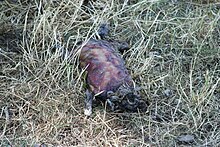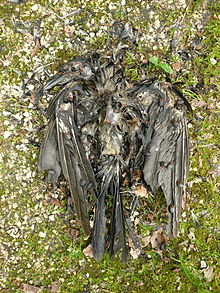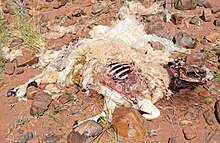Carrion

Under carcass or carcass (Latin cadaver ) is defined as the dead body of an animal when it is in the state of decay has passed.
Transition to the decomposition process
Immediately after the death of an animal, it is not a carcass, but a corpse . In the dead animal, complete relaxation of all muscles sets in, then usually follows in a short time, the range is temperature-dependent, rigor mortis . Since this usually occurs within a few hours, a rigid corpse cannot yet be referred to as carrion. It's still fresh meat. The enzymes contained in the meat release rigor mortis after a few days and the muscles relax for the second and last time. These enzymatic processes ( autoproteolysis ) are the first stage of putrefaction. From here on we can speak of carrion chemically, although the meat is still edible for humans and other animals (see hanging out ). The immune system of the dead animal is still partially intact for some time, so that bacterial putrefaction can not yet set in , which produces the toxins mentioned below. Antibodies and leukocytes (white blood cells) in the flesh of the corpse continue to actively fight most microbes for days until the antibodies are used up and the leukocytes have used up all of the vitamin C in the corpse that they need for their immune work. Only now does the immune system of the dead animal completely collapse and bacteria colonize the carcass, begin to digest it and multiply exponentially.
State of the carrion, edibility
When it rots, there is a strong carrion odor from the substances cadaverine and putrescine . In addition, the carrion becomes more and more toxic over time through bacterial poisons such as tetanospasmin or botulinum toxin . The foul-smelling putrefaction gases (carrion odor) are generated over a period of weeks and months.
At the beginning of this putrefaction process, the meat is still edible for humans and animals, the final bacterial products are still too weakly concentrated and the smell can be perceived as bearable enough for it to be eaten. At this point in time, the meat is only "well hung" for humans (see skin gout ) and is still common meat for predators . For humans it is by cooking or by soaking in disinfecting liquids, e.g. B. Wine (sauerbraten) or vinegar, even a few days after that to make edible.
As the decay progresses, the carrion odor initially becomes too harsh for humans, other primates, and most feline predators . If they were to eat from it now, they could get sick or die from it because there are now too many bacterial end products for them. Now it is a matter of carrion in the true sense of the word, which is no longer accepted by many carnivores.
Of the scavengers such as the canine predators, birds and a few reptiles, the meat is still gladly taken. When the carrion is finally close to decay and has become inedible for humans and almost all predators, it can only be safely consumed by highly specialized scavengers such as hyenas and vultures . At this point the carrion is highly poisonous to most birds and mammals (including humans).
From the moment of death to complete putrefaction, the dead animal is sought after as food for many insects such as flies , bacon beetles and carrion beetles , especially for their larvae . The insects are usually the first to arrive and the last to leave - this is because the insects and their larvae can only eat slowly due to their small size, while a scavenger with teeth / beak can quickly eat large quantities.
Impact on people and the environment
Rotting carrion is fundamentally a hygienic problem, in particular the water production can be impaired. There are also aesthetic impairments from the sight and smell of carrion. Larger carcasses of whales or cattle can cause specific problems. In these situations, no removal or other disposal of the carcass is possible to be blasting performed. This measure creates smaller parts that decompose more quickly or that are ingested by scavengers (see whale explosion and demolition of dead cattle ).
Others
The word carrion was often used in the 20th century and even more rarely today as a swear word for people, mostly with the same meaning and instead of asshole . ("You carrion")
According to old popular belief, a new animal life developed from the rotting flesh of dead animals. Bees are said to come from dead bulls, wasps from donkeys and hornets from horses. To improve the harvest, a piece of carcass with bone was often placed in the crown when a fruit tree was not bearing fruit. The tree should "be ashamed" and so bring a rich harvest again next year.
See also
literature
- Dirk Schoenen, Michael Carl Albrecht: The decomposition. (= Series of publications by the Association for Water, Soil and Air Hygiene. Volume 113). WaBoLu, Berlin 2003, ISBN 3-932816-42-0 .
- Part 1: Dirk Schoenen: Putrefaction from a hygienic point of view.
- Part 2: Michael Carl Albrecht: Decay from a pedological point of view.
- Carrion . In: Meyers Konversations-Lexikon . 4th edition. Volume 1, Verlag des Bibliographisches Institut, Leipzig / Vienna 1885–1892, p. 11.
- Carrion . In: Meyers Großes Konversations-Lexikon . 6th edition. Volume 1, Bibliographical Institute, Leipzig / Vienna 1905, p. 9 .
Web links
- NECROS project: Animal carcasses and biodiversity. Brandenburg University of Technology Cottbus-Senftenberg (BTU).
- Circle of Life. A new way to support Europe's scavengers. Rewilding Europe, 2017.
Individual evidence
- ↑ Bertelsmann (Ed.): Universal Lexikon . 2006, p. 9 ( books.google.de ).
- ↑ Wolfgang Legrum: Fragrances, between stench and fragrance: Occurrence, properties and use of fragrances and their mixtures . Springer, 2011, ISBN 978-3-8348-1245-2 , pp. 65 ( online ).
- ↑ Klaus Honomichl: Insects: The secret rulers of the world . CH Beck, 2003, ISBN 3-406-41048-0 , pp. 30 ( online ).
- ↑ Handbook of Superstition. Volume 1, 1996, ISBN 3-85001-570-X , p. 13.


